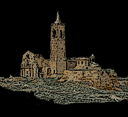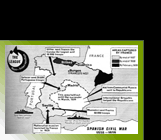 |
 |
|

|
|
|
The Spanish Civil War, which lasted from July 18, 1936 to April 1, 1939, was a conflict in which the incumbent Second Spanish Republic and political left-wing groups fought against a right-wing nationalist insurrection led by General Francisco Franco, who eventually succeeded in ousting the Republican government and establishing a personal dictatorship. It was the result of the complex political, economic and even cultural divisions between what Spanish writer Antonio Machado characterized as the two Spains. The Republicans ranged from centrists who supported capitalist liberal democracy to communists or anarchist revolutionaries; their power base was primarily secular and urban (though it also included landless peasants) and was particularly strong in industrial regions like Asturias and Catalonia. The conservative Basque Country also sided with the Republic, largely because it, along with nearby Cataluña sought autonomy from the central government which would later be suppressed by the centralizing nationalists. The ultimately successful Nationalists had a primarily rural, wealthier, and more conservative base of support, were mostly Roman Catholic, and favoured the centralization of power. Some of the military tactics of the war - including the use of terror tactics against civilians - foreshadowed World War II, although both the Nationalists and the Republicans relied overwhelmingly on infantry rather than modern use of blitzkrieg tactics with tanks and airplanes. While the war lasted only about three years, the political situation had already been violent for several years before. The number of casualties is disputed; estimates generally suggest that between 300,000 and 1,000,000 people were killed. Many of these deaths, however, resulted not from military operations but the brutal mass killings perpetrated on both sides. The war started with military uprisings throughout Spain and its Colonies, which were followed by Republican reprisals against the Church, which Republican radicals viewed as an oppressive institution supportive of the old order. There were massacres of Catholic clergy and churches, and monasteries and convents were burned. In the wake of the war, the winners began a program of mass killing of opponents where house searches were carried out, and unwanted individuals were often jailed or killed. On all sides, brutality was common. The impact of the war was massive: The Spanish economy took decades to recover. The political and emotional repercussions of the war reverberated far beyond the boundaries of Spain and sparked passion among international intellectual and political communities, passions which still are present in Spanish politics today. Republican sympathizers proclaimed it as a struggle between "tyranny and democracy", or "fascism and liberty", and many young, committed reformers and revolutionaries joined the International Brigades, which thought saving the Spanish Republic was the front line of the war against fascism. Franco's supporters, however, especially the younger members of the officer corps, viewed it as a battle between the red hordes (communism and anarchism) versus "Christian civilization". These dichotomies were inevitably oversimplifications: both sides had varied and often conflicting ideologies within their ranks, and motivations for involvement in the hostilities differed. Spanish Civil War |
|
